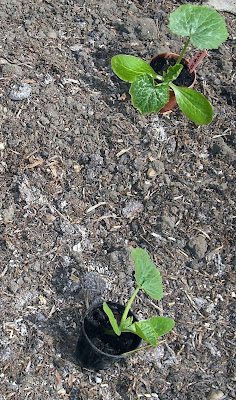 My fennel has produced long abundant feathery fronds. I never knew what to do with them as I only had ever eaten the bulb and thought the top growth was used just as a herb or garnish. But then I bought the Kitchen Sisters (a fantastic radio programme on NPR in the USA) Hidden Kitchens book after listening to the series online. In it was a recipe for Wild Fennel Cakes from a guy in San Francisco called Angelo Garro. I use my cultivated fennel instead and it is a revelation and absolutely my favourite thing. Sometimes I brush the cakes with olive oil and bake or grill them instead of frying them as the recipe suggests. (Sorry about the poor quality of the photo!)
My fennel has produced long abundant feathery fronds. I never knew what to do with them as I only had ever eaten the bulb and thought the top growth was used just as a herb or garnish. But then I bought the Kitchen Sisters (a fantastic radio programme on NPR in the USA) Hidden Kitchens book after listening to the series online. In it was a recipe for Wild Fennel Cakes from a guy in San Francisco called Angelo Garro. I use my cultivated fennel instead and it is a revelation and absolutely my favourite thing. Sometimes I brush the cakes with olive oil and bake or grill them instead of frying them as the recipe suggests. (Sorry about the poor quality of the photo!)I also play the quantities by ear but you do need a lot of the fronds to make this.
1.5 lbs of wild fennel fronds
3 eggs
1 cup high-quality parmesan cheese
1 cup coarse bread crumbs (made from day-old bread ground up in a food processor or blender)
1 teaspoon crushed red pepper
Salt and black pepper to taste
Extra virgin olive oil
Peanut 0il
Directions for gathering and cooking:
Gather young fennel fronds –-- about 1 1/2 pounds. Fennel hearts are the bright green, furry piece that is in the center of the stalk of fennel. When you're gathering them, pick only the fronds and lay them in a paper bag horizontally -- all the tops should be pointing in the same direction. Keep them laying horizontally as you wash them gently in a bucket of water, holding them in your hands to avoid bruising.
Wash and parboil for 15-20 minutes. Make sure to wash fronds very well. Lay the stalks on the cutting board and chop finely. Taste to make sure they are tender. Drain and dry in own steam -- you can stir a little with a wooden spoon to help the cooling process. When the fronds are cold, place in a bowl.
Mix all the dry ingredients together. Form into patties. Heat cast iron or non-sticking frying pan with a very little bit of olive oil cut with a very small amount of peanut oil. Fry fennel cakes on both sides until golden brown. Sprinkle with salt and pepper. Drain again on a paper towel. Best when served warm.
NB I don't use the really big stalks but strip the thinner ones of the main one.

Here a two of the three zucchini I planted with seeds given to me by my friend Darren. They were just about to go into the ground that has been mulched with mushroom compost. It keeps the moisture in and that's important I think for gross feeders like zucchini.
I have also planted my uchiki japanese onion squash which were a great success last year and saw me through the winter because they stored very well (I handled them very carefully to avoid bruising and rot setting in).
I have also planted out almost all of my borlotti beans which I persevered with even though many of the first sowing rotted in the ground and didn't germinate.
New sowings of endive and lettuce are also ready to go while a couple of my first lettuce planted from modules a couple of months ago are already running to seed!
The onions are looking great - I have been told to pick off the seed heads as soon as they form. I will harvest them and
the garlic soon.
Strawberries are also producing beautiful tasty fruit. I have to get them before the slugs and blackbirds do - so far not doing too badly.
I made a great lasagne the other day. Sheets of pasta layered alternately with homemade tomato sauce, ricotta (2 x 250g tubs) mixed with cooked swiss chard chopped, peas and a tablespoon or two of pesto mixed in. Finish off with grated cheddar and parmesan.
















